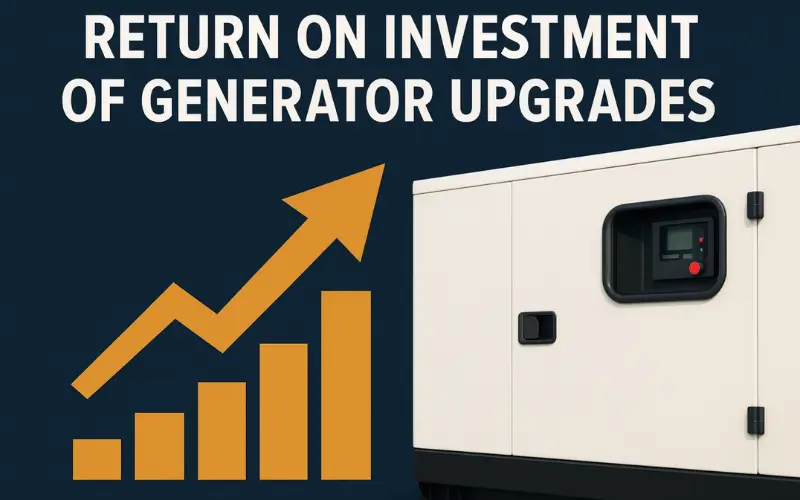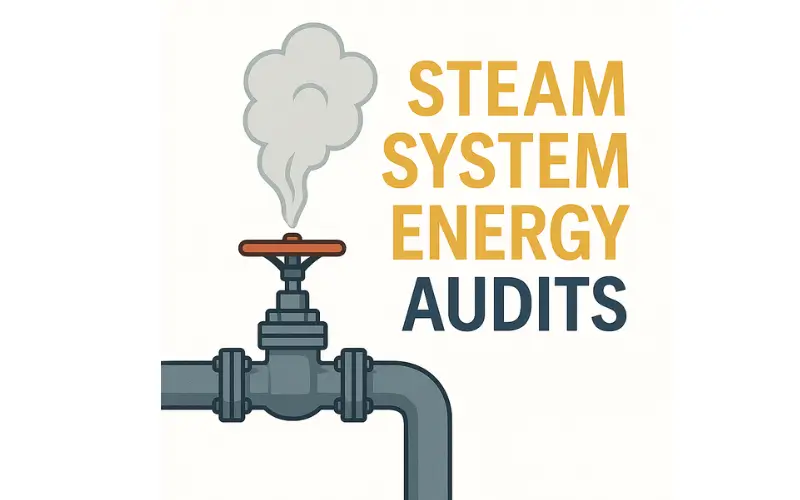When the power goes out, the cost isn’t just about inconvenience—it’s about lost productivity, spoiled goods, delayed operations, and sometimes even safety risks. That’s where a generator becomes more than just a backup plan—it’s a business asset or a home investment. But here’s the real question: Is your current generator giving you the best return on investment (ROI)?
Upgrading a generator isn’t cheap. Between the purchase price, installation, maintenance, and fuel, you could be spending thousands. Yet, when done strategically, the right upgrade can pay for itself faster than you think—through reduced downtime, lower fuel consumption, higher resale value, and even insurance savings.
In this guide, we’ll break down exactly how to measure generator ROI, what costs and benefits to consider, and how real-world upgrades—from residential standby systems to industrial-scale power solutions—have delivered impressive payback periods. Whether you’re a homeowner tired of spoiled food during outages, or a facility manager calculating the cost of production delays, you’ll get the tools and insights to make your upgrade a financially sound decision.
Understanding ROI in Generator Upgrades
What Is ROI?
Return on Investment (ROI) is a measure of how much value you gain from an investment compared to its cost. It’s usually expressed as a percentage using the formula:
ROI = (Total Returns − Total Costs) / (Total Costs) × 100
A positive ROI means the upgrade has generated more value than it cost, while a negative ROI means the upgrade cost more than the benefits it provided.
For generator upgrades, your “returns” can include:
- Avoided costs — money you don’t have to spend (e.g., renting backup power, replacing spoiled inventory, or paying overtime due to downtime).
- Increased value — higher property resale value or improved business capacity.
- Operational savings — reduced fuel usage, lower maintenance costs, and less downtime.
Why ROI Matters for Generator Upgrades
Upgrading a generator is more than just buying a bigger, newer machine—it’s an investment decision. Understanding ROI helps you:
- Compare options – Determine if upgrading to a more fuel-efficient model or adding automation will pay off faster.
- Plan budgets – Accurately project payback periods to decide when to invest.
- Justify costs – Present a business case to stakeholders or lenders showing the financial benefits.
Example:
- Old diesel generator costs $500/month in fuel and maintenance.
- Upgraded model costs $350/month to run, saving $150/month.
If the upgrade costs $6,000, your payback period is 40 months ($6,000 ÷ $150), and your ROI improves significantly over the generator’s lifetime.
Key ROI Metrics for Generator Upgrades
When evaluating upgrades, consider:
- ROI % – Shows the profit ratio from your investment.
- Payback Period – Time it takes to recover the initial cost from savings/returns.
- Total Lifetime Value – All financial benefits generated over the generator’s lifespan.
- Net Present Value (NPV) – Future savings adjusted for inflation and the time value of money (important for large industrial upgrades).
Types of Generator Upgrades and ROI Drivers
Upgrading a generator can mean many things—from swapping a small portable unit for a standby model, to integrating smart monitoring systems into a large industrial generator setup. The ROI potential depends on the type of upgrade and the factors that drive savings or added value.
Home Generator Upgrades
- For homeowners, ROI often comes from avoided outage costs and added property value.
Common Upgrades:
- Automatic Transfer Switch (ATS): Eliminates manual startup, restoring power instantly during outages.
- Fuel Source Conversion: Switching from diesel to natural gas or dual-fuel systems for reliability and lower running costs.
- Capacity Upgrade: Moving from a portable unit to a whole-house standby generator.
ROI Drivers for Home Generators:
Outage Cost Avoidance
- Food spoilage: $200–$400 per outage
- Lost work-from-home productivity: $25–$75 per hour
- Hotel stays during extended outages: $150–$300/night
Resale Value Increase
- Standby generators can add 3–5% to a home’s market value (e.g., $15,000–$25,000 on a $500k property).
Insurance Discounts
- Some insurers offer 2–5% annual premium reductions for homes with standby power.
Commercial Generator Upgrades
For small businesses, ROI is tied to downtime prevention and operational savings.
Common Upgrades:
- Fuel-Efficient Models: Lower consumption per kWh produced.
- Load Management Systems: Prevent overloading and improve efficiency.
- Remote Monitoring: Cuts response times and reduces emergency repair costs.
ROI Drivers for Businesses:
- Lost sales avoidance during outages.
- Reduced overtime costs for catching up after downtime.
- Savings on temporary power rentals (often $500–$1,000/day).
Industrial Generator Upgrades
Large-scale operations have more complex ROI calculations, often involving continuous operation and process efficiency.
Common Upgrades:
- High-Capacity Diesel/Natural Gas Units: Support large facilities without interruption.
- Parallel Systems: Multiple generators working together for redundancy and efficiency.
- Waste Heat Recovery (CHP Systems): Capture heat from generator operation to power other processes.
ROI Drivers for Industry:
- Fuel Savings: Even a 5% efficiency improvement can save thousands annually in large plants.
- Production Continuity: Avoids output loss during outages (measured in $ per downtime hour).
- Rental Avoidance: Eliminates need for costly temporary industrial generators.
Specialized Generator Cases (Example: PSA Nitrogen Generators)
Not all generators produce electricity—some generate gases like nitrogen for industrial processes.
ROI Example:
- Old method: buying nitrogen cylinders
- New method: PSA nitrogen generator
- Payback: as fast as 3–5 months in 24/7 operations due to huge supply cost savings.
How to Calculate ROI — Step by Step
Calculating the return on investment (ROI) for a generator upgrade isn’t complicated if you break it into structured steps. You just need accurate cost and savings data, then apply a simple formula.
Step 1: Define the Total Investment Cost
Your investment includes all expenses required to upgrade:
- Purchase Price of the generator or upgrade kit
- Installation Costs (labor, permits, electrical work, fuel connections)
- Transportation & Setup fees
- Training Costs for operators (if commercial/industrial)
- Miscellaneous Costs (site prep, housing/enclosures)
Example:
- New standby generator: $8,000
- Installation & permits: $2,000
- Total Investment Cost = $10,000
Step 2: Identify Annual Returns (Savings & Added Value)
ROI isn’t just about money earned—it’s also about costs avoided and value gained.
For home generators, returns may include:
- Avoided food spoilage: $300/year
- Avoided hotel stays: $500/year
- Insurance premium discount: $200/year
- Increased property value: $15,000 (counted once if selling)
For commercial/industrial generators, returns may include:
- Avoided downtime costs: $2,000/hour × hours avoided per year
- Fuel savings: $1,500/year
- Rental avoidance: $5,000/year
- Labor savings: $1,200/year
Step 3: Apply the ROI Formula
ROI (%) = (Annual Returns or Savings − Investment Cost) / (Investment Cost) × 100
If you want payback period:
Payback Period (years) = Investment Cost / Annual Returns or Savings
Example Calculation (Home Generator):
- Investment: $10,000
- Annual savings: $1,500
- ROI in first year: (1,500 − 10,000) / (10,000 ×100) = − 85% (negative because payback hasn’t happened yet)
- Payback period: 10,000÷1,500=6.67
Step 4: Factor in Maintenance & Lifecycle Costs
Generators have ongoing costs that reduce ROI if ignored.
- Annual Maintenance: $450–$800/year for standby units
- Fuel Costs: Diesel, gas, or hybrid running expenses
- Part Replacement: Batteries, filters, belts over time
Step 5: Use Comparative Scenarios
To see if upgrading makes sense, compare your current setup vs. upgraded setup:
| Factor | Current Generator | Upgraded Generator | Difference (Savings) |
| Annual Fuel Cost | $5,000 | $3,500 | $1,500 |
| Annual Downtime Loss | $4,000 | $0 | $4,000 |
| Annual Maintenance | $700 | $500 | $200 |
| Total Annual Savings | — | — | $5,700 |
If the upgrade costs $15,000:
- Payback period = $15,000 ÷ $5,700 ≈ 2.63 years
- ROI after 5 years = ((5,700×5) −15,000)/15,000 × 100 ≈ 90%
Real-World Examples & Scenarios
While formulas are useful, numbers become more meaningful when you see them applied to actual situations. Below are examples from different contexts—home, commercial, and industrial—to illustrate how generator upgrades can deliver impressive returns.
Example 1: Homeowner Upgrading to a Standby Generator
Scenario:
- Location with frequent storms causing 4 outages/year
- Each outage costs ~$300 in food spoilage and $250 in lost remote-work productivity
Upgrade:
- Installed a natural gas-powered standby generator with Automatic Transfer Switch (ATS)
- Total investment: $9,500 (equipment + installation)
Annual Returns:
- Outage avoidance: ($300 + $250) × 4 = $2,200/year
- Insurance discount: $150/year
ROI Calculation:
- Payback period = $9,500 ÷ $2,350 ≈ 4.04 years
- ROI after 10 years = ((2,350×10) −9,500) /9,500 × 100 ≈ 147%
Example 2: Small Business Fuel Efficiency Upgrade
Scenario:
- Retail store uses a diesel generator during weekly load-shedding (6 hrs/week)
- Old unit consumes 4 liters/hour at $1.20/liter
Upgrade:
- Switched to a fuel-efficient generator consuming 2.8 liters/hour
- Total investment: $6,000
Annual Returns:
- Fuel savings: (4 − 2.8) × 6 hrs/week × 52 weeks × $1.20 = $449/year
- Maintenance savings: $200/year
- Downtime cost avoidance (fewer breakdowns): $1,000/year
ROI Calculation:
- Payback period = $6,000 ÷ $1,649 ≈ 3.64 years
- ROI after 7 years = ((1,649×7) −6,000)/6,000 × 100 ≈ 92%
Example 3: Industrial Plant Adopting Parallel Generators with Waste Heat Recovery
Scenario:
- Manufacturing plant loses ~$25,000 per hour in downtime during outages
- Existing single generator setup fails 2–3 times/year, causing 4 hours downtime total
Upgrade:
- Installed parallel generator system with waste heat recovery (CHP)
- Total investment: $500,000
Annual Returns:
- Downtime avoidance: $25,000 × 4 hrs = $100,000/year
- CHP fuel savings: $30,000/year
- Maintenance savings: $10,000/year
ROI Calculation:
- Payback period = $500,000 ÷ $140,000 ≈ 3.57 years
- ROI after 10 years = ((140,000×10) −500,000)/500,000 × 100 ≈ 180%
Example 4: PSA Nitrogen Generator Upgrade
Scenario:
- Company previously bought 40 nitrogen cylinders/day at $5 each
- Switched to on-site PSA nitrogen generator
Upgrade:
- PSA unit + installation: $25,000
- Power cost: $8/day
- Maintenance: $100/month
Annual Returns:
- Cylinder cost savings: $5 × 40 × 365 = $73,000/year
- Less power & maintenance cost: ($8 × 365) + ($100 × 12) = $3,920/year
- Net annual savings: $73,000 − $3,920 = $69,080/year
ROI Calculation:
Payback period = $25,000 ÷ $69,080 ≈ 0.36 years (~4.3 months)
ROI after 5 years = ((69,080×5)−25,000)/25,000 × 100 ≈ 1,281%
5. Maximizing ROI on Generator Upgrades
A generator upgrade is a big investment, but the returns can vary greatly depending on how you plan, operate, and maintain the equipment. These strategies will help you shorten payback periods and maximize long-term value.
1. Choose the Right Upgrade for Your Needs
The best ROI comes from aligning generator capacity and features with your actual usage.
- Avoid overcapacity: An oversized generator increases fuel and maintenance costs without proportional benefits.
- Consider fuel type: Natural gas or dual-fuel models often have lower operating costs than diesel.
- Add automation: Features like an Automatic Transfer Switch (ATS) reduce downtime and human error.
2. Improve Fuel Efficiency
Fuel is often the largest ongoing expense for generator operation.
- Upgrade to a more efficient engine — modern designs can cut fuel use by 10–20%.
- Implement load management — running the generator at optimal load reduces wastage.
- Switch fuel sources — in some regions, natural gas or LPG may be far cheaper per kWh than diesel.
3. Schedule Regular Maintenance
Neglecting maintenance can destroy ROI by shortening equipment lifespan and causing costly failures.
- Follow manufacturer-recommended service intervals.
- Replace filters, oil, and coolant on time.
- Conduct regular load testing to prevent wet stacking and ensure readiness.
4. Use Remote Monitoring Systems
Monitoring solutions track fuel levels, performance metrics, and fault alerts in real time.
- Reduces downtime by catching issues early.
- Enables predictive maintenance to avoid costly breakdowns.
- Lowers operational costs by reducing site visits for checks.
5. Leverage Financial Incentives
Check for available tax credits, rebates, or grants for energy-efficient or renewable-powered generators.
- Some insurers offer 2–5% premium discounts for homes with standby generators.
- Industrial operations may qualify for government energy efficiency programs.
6. Plan for the Full Life Cycle
ROI isn’t just about the first few years—it’s about total lifetime performance.
- Factor in resale value if you plan to upgrade again in the future.
- Consider depreciation schedules if claiming tax benefits.
- Balance initial cost with long-term savings when choosing between models.
Conclusion – The Real Value of Generator Upgrades
Investing in a generator upgrade isn’t just about having backup power—it’s about ensuring reliability, efficiency, and cost savings over the long term.
A well-planned upgrade can pay for itself in reduced downtime, lower fuel costs, and higher operational resilience.
When calculating ROI, remember to factor in both tangible savings (like reduced fuel usage and maintenance costs) and intangible benefits (like avoiding lost revenue during outages or meeting compliance requirements).
Ultimately, the best ROI comes from:
- Choosing the right generator for your needs
- Maintaining it properly
- Optimizing its operation for fuel and load efficiency
- Leveraging financial incentives and tax benefits
By following these principles, your generator upgrade can move from being a simple equipment purchase to a strategic business investment that keeps paying you back for years.
FAQs – Generator ROI
1. How do I calculate ROI on a generator upgrade?
- ROI = (Annual Savings – Annual Costs) ÷ Initial Investment × 100%.
Include savings from reduced downtime, fuel efficiency, and maintenance.
2. How long does it take to see a return on a generator investment?
Typically 2–7 years, depending on usage, fuel prices, and the cost of outages.
3. Does fuel type affect ROI?
Yes — natural gas and LPG often have lower operational costs than diesel, which can improve ROI.
4. Are standby generators worth the investment for homes?
For homes in outage-prone areas, they can quickly pay off by preserving food, preventing property damage, and maintaining comfort.
5. Can generator upgrades qualify for tax credits?
Some energy-efficient or renewable-fuel generators qualify for tax incentives or rebates—check local regulations.
6. What is the average lifespan of a generator?
With proper maintenance, 15–30 years depending on model, usage, and environment.
7. Is it better to repair or replace an old generator?
If repair costs approach 50% of replacement cost and the unit is past 70% of its expected life, replacement often delivers better ROI.




